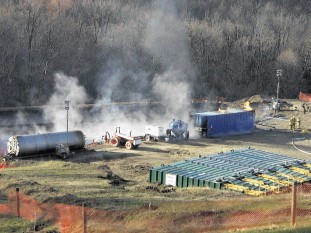
The rally in crude oil is reviving the US shale boom, threatening speculators who are the most bullish on prices since July.
Money managers increased their net-long position in West Texas Intermediate crude by 3.9 percent in the seven days ended May 5, US Commodity Futures Trading Commission data show.
That’s a level last seen toward the start of last year’s price crash. Short positions declined to the lowest this year.
A 37 percent rebound in WTI since March has encouraged companies including EOG Resources Inc. to lay out plans to resume drilling. The shale boom had stalled amid a record decline in rigs seeking oil, and the government is predicting lower output this month.
Any acceleration in drilling will raise concern that the US supply glut could worsen.
“We could soon see a second surge of production growth,” Stewart Glickman, an equity analyst at S&P Capital IQ in New York, said by phone May 7.
“EOG is a rather conservative company so if they are willing to dip their toes back in the water, others will as well.”
WTI futures gained $3.34 to $60.40 a barrel on the New York Mercantile Exchange in the period covered by the CFTC report. The contract lost 16 cents to $59.23 a barrel in electronic trading at 11:44 a.m. Singapore time.
EOG, the biggest US shale oil producer, said May 5 that it plans to increase drilling as soon as prices stabilize at about $65.
Shale-oil explorer Pioneer Natural Resources Co. said it’s preparing to deploy more rigs as early as July, while Carrizo Oil & Gas Inc., Devon Energy Corp. and Chesapeake Energy Corp. last week raised their full-year production outlooks.
Following the announcements, prices tumbled 3.3 percent on May 7, having reached this year’s high.
Even as the number of rigs seeking oil fell for a 22nd consecutive week as of May 8, there were some signs of improvement.
Drillers returned one rig to the Permian Basin, the nation’s biggest oil play, Baker Hughes Inc. data show. That followed the addition of a rig a week earlier in the Willison Basin, where North Dakota’s Bakken shale formation lies.
“A lot of people piled in thinking that production is going to fall off dramatically,” John Kilduff, a partner at Again Capital LLC, a New York-based hedge fund that focuses on energy, said by phone May 8.
“But the likelihood is that more production is going to come online, not less. Things are only going to get worse.”
Oil output will decline from June through September before rebounding in the final quarter of this year, the Energy Information Administration forecasts.
Production will average 9.23 million barrels a day this year, the highest since 1972, and rise to 9.31 million in 2016.
Crude stockpiles slipped 3.88 million barrels in the seven days ended May 1 after expanding for 16 consecutive weeks to 490.9 million.
That’s the highest level since 1930, based on monthly records. Inventories are more than 100 million barrels above the five-year average for this time of year.
Oil prices increasing to $65 for an extended period may add an extra 500,000 barrels a day by the end of next year, according to Bloomberg Intelligence.
The number of wells waiting to be hydraulically fractured, known as the fracklog, has increased as companies wait for costs to drop or prices to rise.
Net-long positions in WTI rose by 10,032 to 268,163 futures and options in the week ended May 5. Short bets dropped 18 percent to 63,881, while long positions slipped 1.3 percent to 332,044.
In other markets, net-short wagers on U.S. natural gas fell 43 percent to 72,225. The measure includes an index of four contracts adjusted to futures equivalents.
Nymex natural gas jumped 10 percent to $2.78 per million British thermal units during the report week.
Bullish bets on gasoline fell 2.7 percent to 24,969. Futures climbed 3.1 percent to $2.0634 a gallon on the Nymex.
The US average retail price of regular gasoline gained 0.8 cent to $2.659 a gallon on May 7, the highest level since December, according to Heathrow, Florida-based AAA, the nation’s biggest motoring group.
Bearish wagers on US ultra low sulfur diesel shrank by 38 percent to 8,426. The fuel rose 5.1 percent to $2.0145 a gallon.
As US producers prepare to increase output, other countries keep pumping more oil.
The Organization of Petroleum Exporting Countries produced 31.3 million barrels a day in April, above the group’s quota of 30 million for an 11th month, according to data compiled by Bloomberg.
Saudi Arabia led OPEC in a decision in November to maintain production levels. The group’s next meeting is in June.
“I don’t think OPEC is going to do any kind of cut next month,” Tariq Zahir, a New York-based commodity fund manager at Tyche Capital Advisors, said by phone May 8. “Production here in the U.S. will pick up. You could see significantly lower prices.”
Recommended for you
